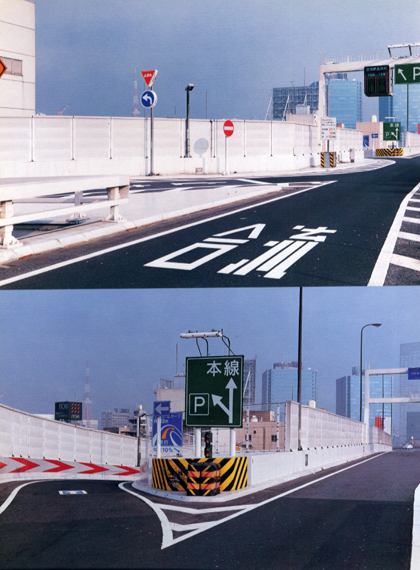
Takashi Homma
“. . . the difference between native peoples and Western peoples [is that] there are still people who know about what came before, and who know that there’s still wild nature available and that they have a relationship to it. Among the native cultures of the world there’s still a memory and a philosophical base for resistance.
As to why some people don’t resist and are done in by it, I’d say it results from a complex of factors. Politically, they’re overpowered. Technology overpowers them . . . We’re uprooted, alienated Westerners feeling vindicated by the fact that now the Indians are also going for it. We look at them and say, “They’re going for the snowmobiles and they’re dropping the dog teams, and they’re dropping the traditional communications in favor of television.”
Jerry Mander
“The extreme point of the technical organization of the world consists in the liquidation of fertility.”
Walter Benjamin
The modern city is all but unlivable now. The architecture of western metropolises is often, now, the source of dread. The political atmosphere, the neo-fascism of Obama’s America, is hidden from by many, by those who can afford to, but for others it is the toxic air that they have to breath. The “sick building” syndrome can be extended to the ‘sick city’. And it is sick in almost all ways one can imagine.
There are such clear chemical poisoning of workplaces today that the list of factors is near endless. Aerotoxic syndrome, affecting airplane cabins, usually connected to de-icing chemicals, or hydraulic fluids being aerosolized, and the history of Legonnaires’ Disease, and just the basic litany of harmful chemicals one finds concentrated in today’s urban landscape have created a literally hostile environment. Gloeocapsa magma is one of those metaphors for climate change that is fraught with certain ironies. The humidity rises, releasing ancient spores. So, there are a couple of levels operative here; the pollutions of daily life, which are reflected, too, in architecture and in social planning, even if not consciously, and the cause and effect of manufactured space, both buildings and commons and restricted pseudo-commons. The mimetic relationship between natural spaces of wonder, or even fear, and their expression in psycho-biopolitical terms in the aesthetics of space.

Olga Rozanova
The growth and growth of density of population of European cities in the middle 1800s, altered the idea of a city at its core. It also coincided, toward the end of the century (cause or effect or both?) with an idea of psychoanalytic models for mental illness. In other words the city was both physically dirty (for workers) and mentally unstable.
Now there is something crucial here, that is shaped by class, by a bourgeois desire to be different from a pathologized working class. The ruling class, too, felt this impulse toward health, and moral health as well. The European city became the site of something counter-human, and the colonial Empires were, in a sense, recreating their horror of conquest and domination overseas, back at home. The city was a reflection of the dark soul of colonial suffering, but reconfigured. There was at the end of the 19th century a sense that people were suffering new varities of anxiety in connection with urban life.
“If agoraphobia was by definition an essentially spatial disease, many psychologists insisted that it was equally an urban disease, the effect of life in the modern city.”
Anthony Vidler

Lewis Baltz
Vidler has written two very good books on architecture, and psychology, and really philosophy. The appearance of psychoanalysis and new conditions such as claustrophobia and agoraphobia seemed pegged to the growth of the Industrial Revolution and the class and gender dynamics of western society at the time. Vidler quotes Charles Melman (in turn borrowing from Lacan):
“The phobic pays a tribute to space, not a symbolic tribute such as one pays to a dead father, but a tribute to the imaginary itself; and we all pay one of these. We know in effect that in space there are places that are privileged or are called sacred and are seperated from the rest.”
Wilhelm Worringer saw agorophobia as part of what drove an urge toward abstraction in art. Worringer also saw ancient Egyptian architecture as an expression of spatial anxiety. I think this is very interesting because it marks a particular moment in the rise of a confusion about space and meaning, about art and culture in their relationship to how systems of control operate. For Worringer was aware that the desire for familiar space was subsuming other factors. For this was the start of (or the intensification of) the destruction of traditional community relations. The city was growing as an expression of societal control. The Panopticon. What Lukacs’ called ‘the transcendental homelessness’ of modern man was reflected in certain architectural motifs. But more, as Vidler points out, writers such as Walter Benjamin and Krakauer were exploring the deeper meaning of passages or lobbies. And throughout all of this was the generalized pathologizing of the masses. Spatial relations mirrored psychological dynamics, and certain spaces took on a meaning as an expression of social conditions. Human relations to Nature were becoming human relations to power.

Luigi Ghirri
“It is not just by chance that the metropolis, the place of absolute alientation, is at the very center of concern for the avant garde.”
Manfredo Tafuri
Tafuri saw on an ideological level, the same contradictions in Enlightenment architecture that would surface in contemporary art.
“And here it is significant that, in exactly the moment when bourgeois economy began to discover and invent its own categories of action and judgement, giving to ‘values’ contents directly commeasurable with the dictates of new methods of production and exchange, the crisis of the old system of values was immediately hidden by recourse to new sublimations, rendered artificially objective by means of the call to the universality of Nature.”
Manfredo Tarfuri
The logical end of this is the post modern hyperbranded landscape of today’s mega cities. There are additional ideological factors that connect to the anthropomorphicizing of manufactured space today. This is linked to the Disneyfication of urban space, as well.
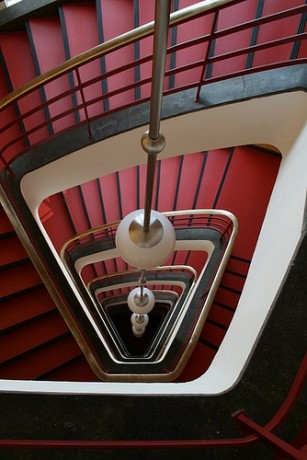
Haus des Rundfunks, Hans Poelzig architect 1929
Brad Evans has written a very insightful essay on Airports I want to quote from here:
“The airport is an experimental site in the regulation of transient populations that
requires the securitization of life in terms of its circulations and planetary
flows. Indeed, in terms of the human-technological matrix so integral
to modern regimes of security governance, the terminal validates the
Deleuzian notion of a “Control Society” whose bio-political contours
have effectively displaced age old ideas concerning life’s grounded/
fixed qualities (including foundational notions of identity) by regimes of
digitalized power and human surveillance that taking life as its principle
object prioritize and problematize all forms of movements – especially the
capacity for flight.”
Now, how this is involved in the creating of narrative and the practice of theatre, is really the topic I want to try to scratch the surface of here. For in today’s urban life there is a constant kitsch experience of revelation, or spiritual awakening, or of reassurance about safety, and of course the never ending eroticizing of almost everything. So commonplace are these effects as expressed in structural space, that most go unnoticed. In the same way surveillance is gradually becoming incorporated into our interpretations of all scenes, and all space. From the gym to the market to public transporation; from leisure activities to bureaurocratic obligations, everything is infused with ideological content, but also reduced to a cartoon-like infantile distraction. The pliable plastic wrapper on the apple you buy, with brand emblems, is toxic, is killing our oceans and ourselves, but the smiley face assures us this isnt really so. The agoraphobic resonance is enforced: dont leave, don’t stray “outside”. Literally and figuratively.
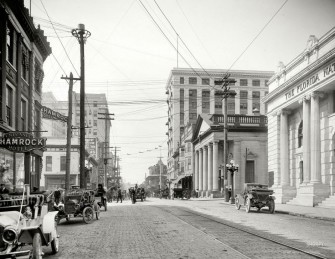
Jacksonville Florida, 1910
The reification that happens in consumer society created the paradox of the too intense identification with products, and the ever greater distance from actual human interaction. Class segregation became part of all design plans for city living. At one end were the gated communities of the rich white proprietor class, and at the other end the disorganized holding pens for the masses. The areas of business have increasingly become studies in crowd control. The contradiction in this is the marketing of products in which emotions are stimulated and attention harvested. The role of attention is significant in all this, for all narratives operate today with certain default settings in place for fictional characters behavior. Increasingly, these narrative conventions are wildly inaccurate. I wrote last post about the loss of intimacy in basic community interactions. Oral interaction has been severaly curtailed, to the degree that conversation feels increasingly illicit. Talk must be clearly motivated or risk suspicion.
In the 1920s Siegfried Kracauer wrote an essay on hotel lobbies. He had also written on the detective novel, in which the lobby of Grand Hotels was a central feature. Walter Benjamin, of course, had written a good deal about the Paris Arcades. Vidler quotes an interesting comment of Charcot’s about one of his patients:
“If i wanted to define this patient’s mental state, I would, like both the poet and physician, say that here is a patient who appears asleep but who behaves like you and me, and we, of course, are awake.”
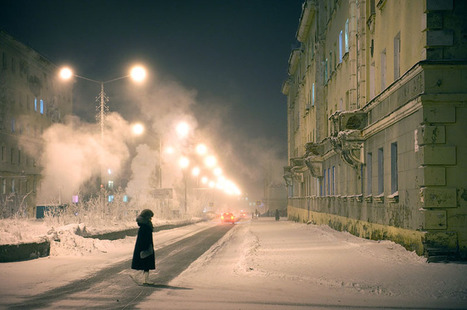
Elena Chernyshova
This returns us yet again to Freud’s essay The Uncanny. And to the topic of automatons and marionettes, the paranoia of those ‘who walk among us’, and the *other*. It also links to Macbeth. For the idea of sleepwalking became a pathology at the same time as the rise of great metropolises. For Benjamin and Adorno, as well as Horkheimer, there were associations with exile and the nomad. The primordial nomadic landscape, the wanderer, had migrated to the urban deserts and wilderness. The same uncertainty awaited. The same but different. Vidler points out cogently that there was an additional space, the underground, the Metro. This was the modern labyrinth. The dragon below, the unconscious. There are a host of factors here, each of which could fill an entire volume. The privileging of vision over auditory organization, and the distancing quality of vision itself. Vidler makes a case for *transparency* as the prevailing aesthetic of modernism. LeCorbusier certainly thought so. And if this is true, at least in part, then the post modern metropolis, the surveillance city, is one in which seeing is no longer the issue, but rather being seen. But being seen by the technological eye of the CCTV camera.
There were new spaces, architectural spaces, the de-ritualized spaces of state control.
Evans again on airport terminals:
“The hidden violence is all too evident. Every gesture, every word,
every act is monitored such that the force of law appears through both
the immanent possibility of a violent response by overtly militarized
security personnel, along with the more subtle forms of violation that
are underwritten by the deepest suspicions about the subject who
must not only prove their credentials before being “welcomed in” but
continue to evidence full compliance.”
The theatre remains one of the last sacred or ritual spaces. But today’s playwrights avoid this fact because to engage it would mean commercial failure. One aspect of theatre that probably accounts for its relative unpopularity today is the fact that perhaps more than ever the stage looms as the least mediated social space left in western society. One cannot watch a play in a state of distraction. Well, you *can* (and often critics, for example, do) but compared to the increasingly distracted attention, or passive attention given to one’s surroundings today, certainly in urban areas, the stage remains a ritualized and energetically charged portal to that off-stage or daemonic or uncanny place in our psyche. Even saying *in* our psyche betrays spatial prejudice. I am less interested, however, at least in this post, with the optical privileging, and the tensions that exist with tactile and audial perception. For before that, I think it worth discussing the architecture of private space. The architecture of our inner life. First, I think on the one hand, there is too much emphasis put on the difference between town and country, while on the other hand, perhaps not enough emphasis is put on ‘certain’ factors of difference between these landscapes. I think the urban dweller remembers, even if not aware, of the natural world, the empty primordial vistas and the terrors of the non electrically illuminated night, and the scope and scale of the seas. I think we retain these spaces, as almost dream architecture, and it shapes, in part, our emotional cartography in daily life. We map our personal lives, and our anxieties are often dreamscapes imprinted on the commercial hyperbranded screen dominant world around us in 2014.

Jeremy Dyer
The actor watched on stage is the not the same as the citizen being observed on CCTV. Then our every internet utterance is catalogued, and social media is stuck away in the big freezer the NSA has in Utah. Our inner journey is curtailed because the Empire is watching and listening. The new staple of authoritarian police state TV narrative is “facial recognition” software; never mind if it actually works very well or not (it doesnt) the quality of our attention is altered. One can watch TV and even film without total focus of attention, and there are many factors linked to this. Gestures are left incomplete, intention fragmented. On stage, we the audience are a mini community because of, not just the breathing actor, but because that actor is on stage in ritual space. One can pass people babbling aloud on streetcorners without much awareness, but on stage, our inner life is being addressed.
Today, the constant pressure of instructions in the form of signs, the intensifying of police visibility, and police violence, and the encouragement to stay only semi-conscious all has led to the atrophy of imagination. The Utopian dream is shrivelling, and when it does surface, it is stunted, short sighted, and often touched with anxiety and guilt. The hyperreal, the simulacra, the post modern is all very carefully designed for short duration, for passive attention, and is, I believe, riddled with the primal anxieties of lost space, lost home. The post modern has forgotten the idea of place. Instead of place, there is commodity.

Dirk Braeckman
On the one hand, I think we are into the second generation (in the West) that actually HAS forgotten, has lost its memory. And the Spectacle has achieved full status for the hyperrealism of mass marketing. The flip side is the absolute destruction of the commons. And in the U.S. some of that is traced directly back to Jefferson. This was architecture as moral instruction, architecture (and city planning) as cultural organization. It was the p.o.v. of an aristocrat. This links to the 1930s, the post-crash reorganizing of Capital, and of capital as public shrine. The buildings and public spaces that followed were part of the necropolis. I would argue with both Tarfuri and Vidler at this point, because I think LeCrobusier’s role is misunderstood. Philip Johnson (and Graham, and Van der Rohe, and Van Allen right up to Norman Foster) are the architects of death, or of money. The shrines to expanding god-like Capital. Tarfuri is right, though, about pop art and op art and the role it played as re-purposing the marketed image. But also, right up to Hirst and Koons, this is the art of the *dead now*, the amnesiac necrophilic art of Max Headroom. Death is impersonal, anonymous, and de-linked from contemplation of mortality. It is now all an autopsy. And it harkens back to automata and puppets, but the better to finally kill off the unconscious altogether. The aesthetics of CGI kill the memory of space, in the same way Philip Johnson helped exterminate working class importance, and kill the memory of village agrarian life. For this is a world only of ruling elite. The rodential workers must stay out of sight, underground, or in exile. There is no memory of crafts or labor. But to return to the stage and to home. The role of crime, of transgression continues to interface with narrative. All stories are crime stories (I’ve said) and there is always a violation of space in crime. The breaching of home. The agorophobic’s inner landscape. But houses are metaphorical in special ways. Today there are a number of photographers whose obsessive attachment to buildings devoid of people, to empty black windows, takes us back to the primordial landscape again, and to memory, both personal and collective. But crime reduced to simply police procedures robs the narrative of allegorical potential. In other words, for kitsch TV and film, the reason for crime is never questioned beyond invidiual “badness”. The criminal commits crime because he is a criminal.
There is a clear psychoanlytic bent to this thought. Primal crime, Oedipul issues, and a Romantic aesthetic. I would argue these are all things, however one investigates them, or analyses them, aesthetically or otherwise, their loss is part of the totalitarian project of 21st century thought and education. The white snark of post modern hipness can applied to *anything*, literally anything. There is no cost to snark. No foot notes. Snark is self enclosed, self generating, self abiding. The loss of place, and really the loss of clear descriptions or definitions for home, are connected to amnesia and this the ascendent irony of white Imperial rule.

Bob Trotman
The uncanny is both the recognizing of something familiar in the obviously strange or unusual, and the recognizing of the something strange in the normal or everyday. Lacan would say we are projecting our desire in either case. I would probably argue for only a handful of 19th century writers expressing something of this existential uncanny, this foreshadowing of the modern and post modern malaise. Melville is certainly one, in Bartelby the Scrivner, The Confidence Man, Beneto Cereno, and Moby Dick, and I think Conrad, too, perhaps oddly, in Nostromo. In the 20th century, these elements are present in Pedro Paramo, the Juan Rulfo novella, and in different ways in Patricia Highsmith, and later in the black mask crime fiction of Goodis and Woolrich, and in James Cain and even in Chandler and Hammett. The point is that gradually this quality of traumatic memory, or forgotten trauma has left fiction. If we grant Lacan some credibility about the mirror stage, then our primal personal drama is fraught with uncanny space, is even predicated upon an idea of self, space, and rivalry. And these elements were basic cornerstones for Pinter and Beckett, and in a lesser degree for Genet. One of the problems with post modern aesthetics, it seems to me, is that there is no uncanny because there is nothing not utterly familiar. The unfamiliar is the familiar unfamiliar. It is Cindy Sherman or David Lynch, or Greg Crewsdon. And it intersects with camp elements, too. The elite appreciation of junk. The insider trope is all recognizable style code. And all of this was following the marketing departments of major Hollywood studios and networks. And they in turn were following Madison avenue. The dangerous space of a primordial landscape had become the chintz curtained familiarity of a domesticated bourgeois living room, or the antiseptic smoothly running business office. Shows such as Mad Men are, in the end, still depicting a world devoid of interior terror. Terror is only depicted in the lurid narratives of extreme violence, and as exceptional cases.

Niele Toroni
If all stories are crime stories, then all houses (in fiction) are haunted.
“The zoning governing the development of those metropolises made no effot — at first– to hide its class character. … What had allowed Piranesi to mediate the terrifying prophecy of the eclipse of the sacred, with primitivistic nostalgia and flights into the sublime, is also what allowed romantic electicism to make itself the interpreter of the merciless commercialization of the human environment, by immersing in it particles of completely worn-out values, presented in all their contorted muteness and falsity, as if to demonstrate that no subjective effort can regain an authenticity lost forever.”
Manfredo Tarfuri
Tarfuri remarked that the Impressionists faux scientific experiments only hid the real meaning of the environment. And that the political responses introduced a new false utopianism of realized facts, and this was the over valuing of the concrete, the verifible. The Iowa Writers workshop comes to mind here. Manifest Destiny itself was the false conscience of a new realism, the ethics of a particularly American bourgeois sublimation of the real carnage of conquest. Destiny itself, as a concept, was invented in its modern incarnation by the ruling classes. Architecture, said Tarfuri, was the ideology of the *plan*. Utopian dreams had fallen under the weight of unproductivness. The future had to be designed as productive, had to be profitable.
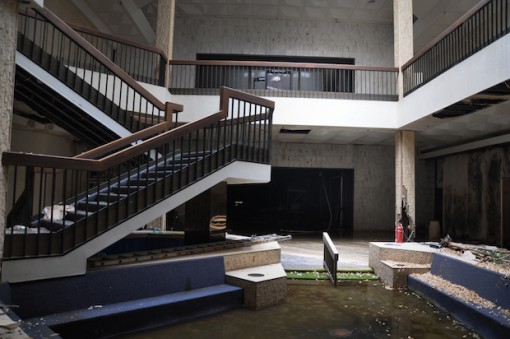
Seph Lawless
Risk management today is the legacy of the intellectual war on dreams and imagination — the dreams that are not productive. It is worth examining, I think, the rise of the idea of ‘the public’. The public as an image is ‘the crowd’. And the crowd is the foundation of the Spectacle. Today public spaces are usually places of waiting, of demoralized ennui, announced as efficient, they are almost always intentionally inefficient. These are places of acute anxiety, from the fear of surveillance to the sense of invisible boundaries, of homogenized herding. Super markets, airports, the unemployment office, or the DMV, or anywhere with waiting areas, anyplace where time stops, in effect manage to do the opposite of what they intend. The ethos of efficiency, of safety and security, has given birth to landscapes of dire alienation. There is an additional factor here, and that is the illusion of information. Departures, numbered waiting, audio announcements, signs of all kinds and none of it tells the crowd anything. The prevailing ideology of institutional space is hostility to the masses. They are a problem. The institution is there to deal with the *problem*. And the problem is people, and the solution is to neutralize said problem.
The point here is that the ideological backdrop of control has resulted in disorientation and an interior vertigo. It is the new dread of lost space. Lost space is really lost place as well. Theatre remains potentially transformative, because the stage cannot be absorbed. Too often today’s theatre landscape is far too close in feeling to the Department of Motor Vehicles or a passport application office. Everything in today’s large cities, wherever one stands, feels as if it is on the border of somewhere uncertain, as if all directions lead to a restricted zone. There are only wrong turns.
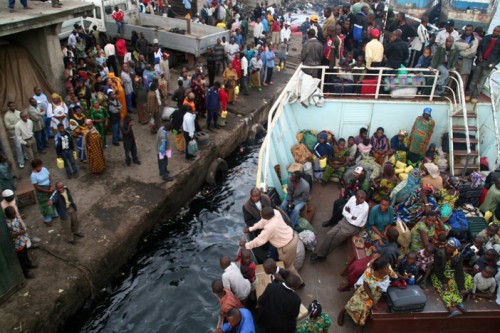
Lake Kivu ferry, DRC, Ann Jones photog.

as usual there is so much to respond to, im going to start at thee end
“Melville is certainly one, in Bartelby the Scrivner, The Confidence Man, Beneto Cereno, and Moby Dick, and I think Conrad, too, perhaps oddly, in Nostromo. In the 20th century, these elements are present in Pedro Paramo, the Juan Rulfo novella, and in different ways in Patricia Highsmith, and later in the black mask crime fiction of Goodis and Woolrich, and in James Cain and even in Chandler and Hammett. The point is that gradually this quality of traumatic memory, or forgotten trauma has left fiction. If we grant Lacan some credibility about the mirror stage, then our primal personal drama is fraught with uncanny space, is even predicated upon an idea of self, space, and rivalry. And these elements were basic cornerstones for Pinter and Beckett, and in a lesser degree for Genet. One of the problems with post modern aesthetics, it seems to me, is that there is no uncanny because there is nothing not utterly familiar. The unfamiliar is the familiar unfamiliar.”
so true and i think there is evidence everywhere of the knowledge how this is lost and how its needed for entertainments, for narartive products in most grnres, and there’s this clunky desperate effort to fake it – to achieve the uncanny unearned. An striking example is Spike Lee’s Miracle at Sta Anna the craziedt worst nuttiest thing i ever saw. It starts off with a bravura war scene and then goes into cranky cheating conusing pomosity in quest of tthis lost capacity to render traumatic memory. Did you see it?anyway that’s a frantic in a sense “honest” example of this, and theloathsome brooklyn hipster couple safran foer and krauss are cynical sleazy examples of ersatz uncanny.
Spaces of waiting– there’s no “file” on Waiting in Arcades project but I always thought there should be on. There’s a lot of stuff inn Arcades that could compose the Waiting file, most of it is filed in Boredom: Eternal Return. That;s where Benjamin stashed his Kafka and the waiting room.
A rich and fasinating discussion, as always. Your blog posts always make me want to reply, but there is so much going on in each of them it is hard to know where to begin. Maybe the link you suggest between the uncanny and a sense of place, or home. I feel that in Melville and in Nostromo too, and in th films of Tarkovsky– especially Stalker. Isn’t the zone in Stalker a portrayal of a world in hich there are only wrong turns? And yet, Tarkovsky places moments of the uncanny, the withdrawn sacred, precisely there. I think this is especially effective in the scene with the black dog who sits beside the Stalker as he lies in the pool of water. And I think you are right that this is very far from the “familiar unfamiliar” of Lynch, who reverses Freud’s uncanny by making the strange a camp playground of some kind. Thanks for your posts, which are always so thoughtful and wise.
Thanks Jerome. Let me work back as well. Yes, Stalker is an absolutely perfect example. And as I think on it, in all Tarkovsky, you’re right , there are only wrong turns. The uncanny is always subtle….a tremor in the stride of someone. Highsmith does that in prose. That story about the guy in a hotel room in Mexico I think. I forget. He hears what he thinks could be a murder next door. But there is nothing to find out finally. Its the missing solution but more, the missing crime. Stalker is a very disturbing film in that way. Its curious that Bergman once almost had that quality. Never fully, but there were aspects of his early films, but that is exactly what left him. The later films are without an Id. They arent haunted. I mentioned this film this year, Mister John…….not a masterpiece, but its very akin to a highsmith story in a way. I think Bowles captures it at times because he knows there are colonial ghosts everywhere. @molly: Ive not seen that, but god, I did see Old Boy. I mean i cant begin to explain why he made that film. Or how awful it is. Anyway…..its true Foer is so strained, his resentments consume anything that might take on allegorical meaning. But everything today feels *fake*…..its costume jewelry….and what seems to be happening is a kind of weird desperation surfacing, but it has no artistic place to go somehow.,